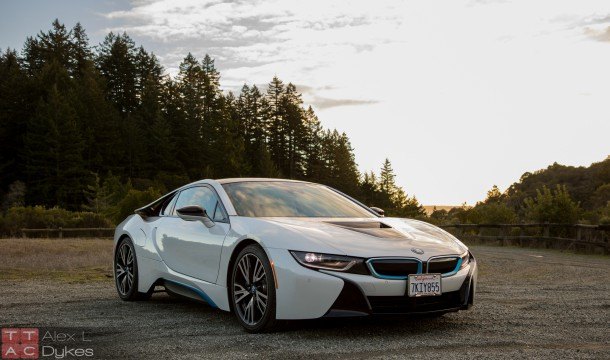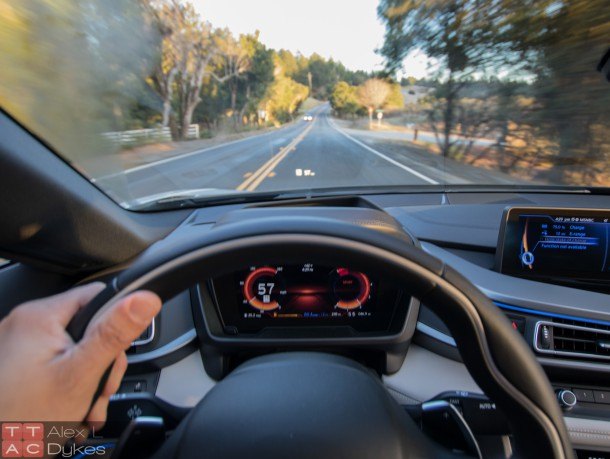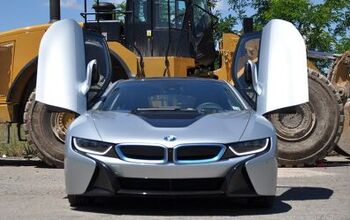2016 BMW I8 Review - The 'Affordable' Plug-In Supercar

2016 BMW i8
“Looks like sex, goes like stink” is the usual supercar mantra, but BMW’s guru was humming a different tune when penning the i8.
You see, the i8 isn’t just a sexy car with “butterfly doors.” It’s also a production prototype of sorts styled after BMW’s 2009 Vision EfficientDynamics concept.
Most supercars have exotic engines with high cylinder counts and drink premium gasoline at an alarming rate. BMW’s mission with the i8 was to make an efficient supercar and at the same time production-test technologies that will trickle down to its higher volume cars over time.
The i8’s efficiency is the key to understanding this sexy German. The i8 isn’t the best handling supercar, or even the best handling BMW. Neither is it the fastest BMW, the most luxurious BMW, or (oddly enough) the most efficient BMW. Instead, the i8 delivers M235i like lateral grip, M4 like acceleration, fuel economy that bests the 320i by a few miles per gallon and lines so sexy I got a thumbs up from a passing F430.
This isn’t your average sports car.
Exterior
No halo car would be complete without an insanely opulent option: For $6,300 BMW will swap out the “that’s so 2014” LED headlamps for laser headlamps. Yep. Lasers. This requires a little explanation.
The car isn’t just shooting a laser beams from its eyes. Instead, it’s using a laser to excite a phosphor that, in turn, generates the visible light you see shining out the front. Why bother? Well, BMW claims they are more efficient than LEDs — but the real reason is so you can tell people at Starbucks that your BMW has “laser headlights”.
The rear-engine design gives the i8 a strong wedge profile, but the microscopic size of the engine means BMW didn’t have to use ginormous air scoops like we see in other super cars. In their place we find small, well-integrated vents in the rear and a large hood vent up front that provides an air outlet for the front-mounted radiators. On the down side, the totally-bitchin’ front vent means you won’t find a “frunk” in the i8.
BMW penned their most exciting rear end to date for the i8. The i8’s roofline and C-pillar morph into a split wing design, dispensing any need for a traditional wing or spoiler. The wing and channels that form the rear lamps provide downforce at higher speeds and direct airflow for a better coefficient of drag.
Most sports cars and supercars ride so low to the ground that they’re impractical for the daily grind of speed bumps and steep driveways. The reason for the low ride height is generally to improve aerodynamics and lower the center of gravity, but the i8 gets to the lowest center of gravity of any BMW product by making the body out of lightweight carbon fibre and jamming a heavy battery and motor low in the chassis. That allowed BMW to give the i8 a very practical 4.6 inches of ground clearance, which is notably more than a Chevrolet Camaro Z/28.
Interior
Although the exterior is sexy and daring, the interior is more traditional than BMW’s larger volume i3. The general design looks like a modern art interpretation of the 6-Series. Aside from some funky ambient light pipes that can glow blue, everything the typical BMW shopper expects is present. All i8s get a standard iDrive display perched on the dash, an LCD instrument cluster and dual-zone climate control.
In order to save weight, BMW uses a six-way power seat design with fixed headrests; no adjustable lumbar support and no seat position memory. The lack of adjustability compared to other BMW models means that the closer you are to six-feet tall, the more likely you are to find the i8 comfortable.
Technically, the i8 is a four-seat coupé, but you should probably think of the leather tuffets in the rear as well-appointed handbag storage. While I was able to find an eight-year-old girl short enough to sit in the rear without her head touching the ceiling, she would have needed a leg amputation to ride with a six-foot tall adult driving the car. The back seats are more usable than those found in a Porsche 911, but that’s not saying much.
Infotainment
The only audio system offered is a lightweight design featuring 11-speakers. The surround sound system features a small subwoofer between the rear seats and a center speaker on the dash. It’s all powered by a 360-watt amplifier, which is about 1,000 watts behind most cars in this price range, but I had no complaints with the sound quality.
Drivetrain
Starting off at the rear of the vehicle, the primary powerplant is a 1.5-liter turbocharged three-cylinder engine from the Mini Cooper with the boost cranked to the stratosphere. In this form, the small engine makes 228 horsepower and 236 lbs-ft of torque, a significant 91-horsepower increase from the Mini. The engine is connected to an 11 horsepower electric motor and a traditional six-speed automatic transaxle made by Aisin that is nearly identical to the unit in the Cooper.
Up front sits essentially the same electric motor that sees duty in the rear of the i3 (except it’s a little less powerful in the i8) producing 129 horsepower and 184 lbs-ft of torque. The front motor uses a two-speed automatic transmission and the car’s computer handles the coordination of shifts between the six-speed gearbox in the back and the two-speed unit up front. Under the center tunnel lies a 7.1 kWh lithium ion battery pack, which is enough to power the 129 horsepower front motor for around 22 miles. When everything is working in harmony, the system’s maximum combined output is 357 horsepower and 420 lbs-ft.
Here’s how the system works: With a charged 7.1 kWh lithium battery, the i8 defaults to “Comfort” mode. This is where the car blends power sources based on demand, but favors the battery as long as retains 10-percent of its charge. Toggling to “Eco Pro” makes efficiency take a front seat. Regenerative braking becomes more aggressive and the car’s computer depends even more heavily on the battery. “eDrive” is engaged by a button and that transforms car into a pure electric vehicle (unless you press the pedal past the “kickdown” switch). If you hadn’t thought of this yet, that means the i8 is a front-wheel-drive supercar in “eDrive” mode. It’s even possible to get a hair of torque steer out if it.
Sport mode is where things get interesting, and its best corollary is “Mountain” mode in the Chevrolet Volt. When engaged, the i8 disables the start/stop system and uses both the front and rear motors to keep the battery charged between 50 and 75 percent. This can be thought of as a “through the road” hybrid system. Although power can flow from the rear motor to the battery, the car will also “overpower” the rear wheels and “regenerative brake” with the front wheels to generate more power than the 11 horsepower motor/generator is capable of on its own. This process is transparent and means that all 357 ponies are always ready to be called on when the road gets twisty or your dot-com organizes a VC track day.
Drive
Putting that in perspective, unless you engage “Sport” mode, the Hyundai Genesis V-8 next to you will be faster from the stoplight. Engage “Sport” and you’ll only be a hair faster to 60 mph compared to the Ford Mustang GT. Try as hard as it might, the i8 will never best an M3 or M4 at the dragstrip.
BMW is no stranger to digitally augmented engine noise, but BMW has now taken faux-burble to an all-new level. In most drive modes the engine is nearly silent. Putting the shifter into “sport” makes the i8 sound more like a Nissan GT-R than a fuel-sipping hybrid. The change isn’t due to fancy exhaust valves, but a high-tech speaker system. Not only does engine noise play in the cabin, it also plays outside via the left exhaust tip. Yep, it’s not a real exhaust but a speaker with a tail pipe. Do I feel cheated? Yes — yet, I have to admit, it sounds believable.
Although the carbon-fiber i8 is about the size of a Corolla, it weighs 119 pounds more than a Honda Accord EX while running front tires that are almost the same size. Yep, the i8 is a sports car with 215/45R20 front rubber. At 3,455 pounds, the i8 is 100 pounds lighter than an M4, but the M car is running 255-width tires up front. Guess which pulls more lateral Gs? Yep, it’s the M4. On the flip side, don’t start thinking the i8 handles like an Accord with summer tires. The i8 is much lighter on the front axle than the Honda, lower to the ground and shod with 245 width tires at the back. That said, your average Corvette or 911 will run rings around the i8 on a track.
Like most hybrids out there, the i8 has to draw from the battery pack to deliver the peak 357 horsepower. When that’s exhausted, all you’re left with is the gasoline engine. That was very obvious in the i3 REX, which makes 170 horsepower total (of which the engine can only supply 34 horsepower) and the software doesn’t allow the engine to charge the battery above a low baseline. The i8 in “Sport” mode, however, charges the battery to near capacity and the engine alone is good for 228 ponies, making it nearly impossible to deplete the battery on public roads (though I’m sure a track would be different). Working a battery hard like this in a normal hybrid or EV would cause it to overheat, so BMW installed a refrigerant-based active battery cooling system. Think of it as “battery air conditioning” to keep the party going.
For a performance car, the i8 is surprisingly easy to live with. Aside from the yoga-pose required to gain entry, the ride is well composed, steering effort is moderate and the i8 might as well be a well-appointed 440i. What surprised me most about the i8 was the seamlessness of its mode transitions. Aside from wet weather traction being an issue in pure EV mode (thank you, skinny front tires), transitions from EV to hybrid to “Sport” modes were almost completely transparent. Transitions from regenerative to friction braking and back are simply the best I have ever experienced.
Thanks to the large battery pack and stout front motor, the i8 feels like a perfectly balanced all-wheel-drive sports car. This isn’t like the eAWD systems we see in the Lexus RX or Acura RLX hybrid that send a small fraction of the power to the rear leaving the car feeling like a front-wheel-drive car 99 percent of the time. The BMW system can direct up to 47 percent of total system horsepower to the front axle on demand, making the i8 in “Sport” mode feel quite similar to BMW’s mechanical xDrive AWD systems.
The i8 is both extremely expensive and, at the same time, strangely cheap. Starting at $140,700, BMW’s sexy hybrid is $27,300 more than an M6, which is faster and handles better. That sounds like a raw deal until you compare the i8 to its two most competitors. Porsche’s 918 Spyder is also a plug-in hybrid with an EV mode, but it will set you back $700,000 more than the i8. No, that’s not a typo. While the 918 is a hardcore performance machine that will eat the i8 alive, you could buy six BMW i8s for the price of one Porsche. A loaded i8 tops out at $159,740, which is right where the 2017 Acura NSX will start. Although the $156,000-205,000 NSX is a tough competitor, its mission is quite different. Acura’s supercar isn’t a plug-in and the hybrid system is tuned towards performance, not efficiency.
In the end, the i8 is a niche car in a niche segment purchased by niche people. Ordinarily, this would make it unimportant for the average car buyer and therefore not high on my “must drive” list — but the i8 is different. As a test bed for future technologies, the i8 excited my inner nerd. The hybrid system is extremely well sorted and the fact that BMW based this system around existing parts, such as its current 1.5-liter engine and a standard six-speed transaxle, means that it could easily be transplanted into an existing BMW by putting the engine up front.
The i8 itself is not destined to grace many driveways, of course. It’s sexy for sure, but it’s also expensive and lacks the desired driving chops
As a supercar, the i8 disappoints. As a harbinger of BMW’s future however, I am intrigued.
BMW provided the vehicle, insurance and one tank of gas for this review.
Specifications as tested
0-30: 1.7 seconds
0-60: 3.9 seconds
1/4 mile: 12.8 @ 114 mph

More by Alex L. Dykes
Latest Car Reviews
Read moreLatest Product Reviews
Read moreRecent Comments
- Kjhkjlhkjhkljh kljhjkhjklhkjh A prelude is a bad idea. There is already Acura with all the weird sport trims. This will not make back it's R&D money.
- Analoggrotto I don't see a red car here, how blazing stupid are you people?
- Redapple2 Love the wheels
- Redapple2 Good luck to them. They used to make great cars. 510. 240Z, Sentra SE-R. Maxima. Frontier.
- Joe65688619 Under Ghosn they went through the same short-term bottom-line thinking that GM did in the 80s/90s, and they have not recovered say, to their heyday in the 50s and 60s in terms of market share and innovation. Poor design decisions (a CVT in their front-wheel drive "4-Door Sports Car", model overlap in a poorly performing segment (they never needed the Altima AND the Maxima...what they needed was one vehicle with different drivetrain, including hybrid, to compete with the Accord/Camry, and decontenting their vehicles: My 2012 QX56 (I know, not a Nissan, but the same holds for the Armada) had power rear windows in the cargo area that could vent, a glass hatch on the back door that could be opened separate from the whole liftgate (in such a tall vehicle, kinda essential if you have it in a garage and want to load the trunk without having to open the garage door to make room for the lift gate), a nice driver's side folding armrest, and a few other quality-of-life details absent from my 2018 QX80. In a competitive market this attention to detai is can be the differentiator that sell cars. Now they are caught in the middle of the market, competing more with Hyundai and Kia and selling discounted vehicles near the same price points, but losing money on them. They invested also invested a lot in niche platforms. The Leaf was one of the first full EVs, but never really evolved. They misjudged the market - luxury EVs are selling, small budget models not so much. Variable compression engines offering little in terms of real-world power or tech, let a lot of complexity that is leading to higher failure rates. Aside from the Z and GT-R (low volume models), not much forced induction (whether your a fan or not, look at what Honda did with the CR-V and Acura RDX - same chassis, slap a turbo on it, make it nicer inside, and now you can sell it as a semi-premium brand with higher markup). That said, I do believe they retain the technical and engineering capability to do far better. About time management realized they need to make smarter investments and understand their markets better.

























































































Comments
Join the conversation
I liked the front view. but Jeez, the sides and rear, no thanks. Tesla has nothing to fear from these folks.
50 year old top BMW tech I know recently was at training class for this car. Biggest issue is defective motor mounts. When they go bad they take out carbon subframe and tab on motor. Solution: software flash reducing engine output. Redonkeyless.